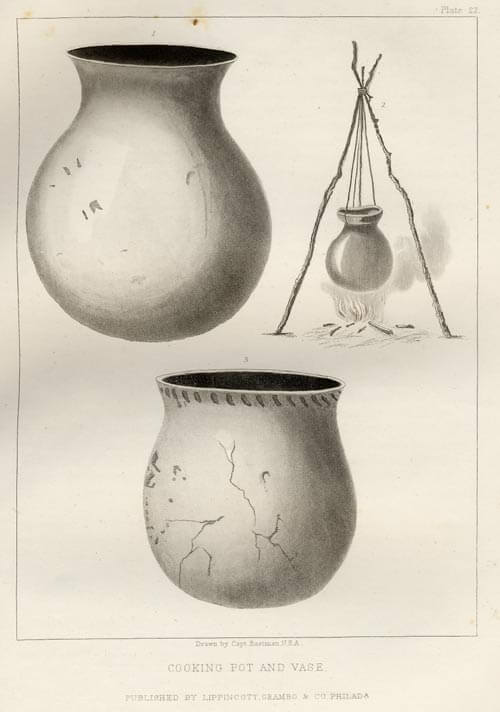
In a state of nature, boiling is performed sometimes by casting heated stones into bark vessels filled with water. One of our tribes, (the Assinoboins,) has been named, it is averred, from this custom. The Micmacs and Souriquois, and some other extreme northern tribes, boiled in this manner. The southern and southwest and midland tribes, from the earliest notices of them, possessed a species of kettle made from pottery, the art of making, which was carried northward up the Mississippi Valley and to the great lakes. The Atlantic and New England tribes, whose traditions point southwest, had also, at the earliest recorded dates, a species of pottery, shreds of which are found at the sites of the oldest villages.
This article was extensively used among the Algonquin tribes, by whom it was called Akeek a word which appears to have been composed from Akee, earth, and the generic ik, denoting something hard or metal-like. It was made of common clay, or clay-earth, tempered with feldspar, quartz, or shells. Sometimes the common black earth of alluvial lands was used by tribes in the South and West, and when so, sands or pounded shells were taken as the tempering ingredient. There was, generally, a ready adaptation to this purpose of the aluminous or other materials of the country possessed by the tribes. Thus the Florida tribes, who possessed rich black soils at the margins of their rivers, and an abundance of shells, made their vessels of these materials; while those tribes living on the banks of the Potomac, Delaware, and other Atlantic rivers, extending quite to the Penobscot, employed the different strata of clays which are to be found along those streams.
In the Mississippi Valley, there is also evidence in the remains of their pottery, of a better ware, formed of the mixed aluminous deposits of its tributaries.
As a general remark, the pottery was a ruder and coarser fabric, as the tribes migrated north. It was essentially with these tribes, an art of the women, who, by a natural law of the division of labor among hunter tribes, were responsible for the preparation for the board of the viands taken in the chase by the men. As a consequence, the potters’ art, which fell into their division, did not advance, but continued stationary at a point, where it had at first been taken up. Among the Iroquois, a very warlike people, it was considered peculiarly the women’s art, 1 and there is every reason to believe that it was thus considered by the Algonquins, Dacotas, and other generic tribes.
The finest and most compact species of pottery is seen in their funereal vases and their pipes, which do not, however, equal the terra cotta. Even in the best specimens which have come to our notice, such as the specimens from the small sacrificial mounds of the Scioto, it falls far short of the quality of the Aztec ware, and infinitely so of the highly-wrought and superb fabrics of Peru. 2
The akeek, (Plate 22, Fig. 1,) to which this article is particularly devoted, is in shape very nearly a globe, with one side opened and turned out as a lip. It has in no instance a foot. It may be used as in a sand-bath, or by a string around the lip, which is attached to a tripod, as seen in Plate 22, Fig. 2.
The only entire specimen of the northern akeeks, which has been examined, was obtained in a cave on an island in the river St. Mary s, Michigan. It is deposited in the cabinet of the New York Historical Society. 2 (See Fig. 1.)
Citations:


